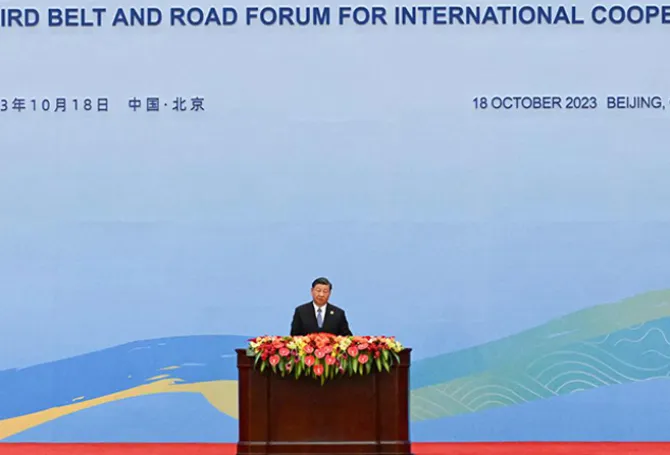-
CENTRES
Progammes & Centres
Location
Even though the tale of Chinese munificence is marred by unsavoury ground realities, all eyes will be on the future of the Belt and Road Initiative

The Third Belt and Road Forum for International Cooperation that was convened in Beijing, China (October 17-18) has put the spotlight back on Chinese President Xi Jinping’s signature initiative. Early debates in China reveal the intent behind the Belt and Road Initiative (BRI). Academic Xue Li likened the BRI to China’s Marshall Plan, stating that it was a gateway for China to transition from a regional power with global influence to a global power with comprehensive strength. Academic Wang Yiwei argued that the BRI was an ascendant China’s bid to reboot globalisation and rectify its shortcomings. A rising China also felt the need to develop new transport and trade arteries as alternatives, since rivals could put the squeeze on the Strait of Malacca — the jugular vein for China’s economy.
Mr. Xi was pitching for the use of local currency in trade, thus in effect elbowing out the dollar.
Beijing was also putting its money where its mouth was with the establishment of the Asian Infrastructure Investment Bank with a $100 billion war chest, challenging other lending institutions. In the assessment of scholar Ju Jiejin, the AIIB would enable Mr. Xi to harvest early gains of the BRI. At the onset, Mr. Xi was pitching for the use of local currency in trade, thus in effect elbowing out the dollar. In this way, he began building an economic order centered on China.
The BRI, which was launched shortly after Mr. Xi got the top job, also served as a vehicle for him to brand himself as a global statesman and project China’s power and influence overseas. Domestically, the initiative entered the Communist Party of China’s constitution in 2017, and got top billing in the 14th Five-Year Plan announced in 2021. The Chinese government’s white paper on BRI released this month (“The Belt and Road Initiative: A Key Pillar of the Global Community of Shared Future”) revealed that over 200 BRI cooperation pacts had been inked with over 150 nations. The document also stated that total two-way investment between China and partner countries from 2013 to 2022 touched $380 billion. As Mr. Xi himself put it, the BRI would provide more public goods to the entire world, highlighting the massive infrastructure deficit.
Under China’s Marshall Plan, motorways, power plants, ports, railway networks, and digital infrastructure have been built.
According to the World Bank, 675 million people are without electricity globally, around 2.3 billion lack potable water, and 450 million live beyond the coverage of a broadband signal. The lending institution calculates that bridging the infrastructure gap will need capital infusion of $1.5 trillion annually through 2030, which is approximately 4.5% of the GDP of low- and middle-income countries. Under China’s Marshall Plan, motorways, power plants, ports, railway networks, and digital infrastructure have been built.
But the tale of Chinese munificence is marred by some unsavoury ground realities. A report from the ISEAS-Yusof Ishak Institute on the BRI has highlighted issues related to ecological damage, displacement of people, disputes over payouts and labour unrest. The findings detail case studies of Indonesia, where things came to a head over anxieties related to Chinese labourers filling up positions earmarked for locals. In Laos, the glistening super-fast trains and impressive dam projects over the Mekong River cannot hide the woes of those left high and dry due to lack of compensation, or others on whom droughts due to dam-construction projects have wreaked havoc. AidData estimates that Laos owes China around $12.2 billion — about 65% of its GDP.
The findings detail case studies of Indonesia, where things came to a head over anxieties related to Chinese labourers filling up positions earmarked for locals.
The China-Pakistan Economic Corridor (CPEC) was conceived over the framework that ties between the two nations were deeper than the ocean, sweeter than honey and higher than the Himalayas. Yet, a Pakistani legislative report unearthed that while China cornered 91% of Gwadar port’s revenue, Pakistan pocketed just 9%. These issues have tarnished the reputation of brand BRI, especially its tagline of ‘win-win cooperation’ as there are perceptions that it is a win for China twice over at the cost of other stakeholders.
After much hand-wringing, efforts are being taken to counter the BRI. In the Donald Trump era, the United States and Japan initiated the “United States-Japan infrastructure investment alternatives in the Indo-Pacific region”. The Joe Biden administration announced the ‘Build Back Better World’ (B3W) initiative that seems to have been reorganised as the Partnership for Global Infrastructure and Investment, which aims to channelise private capital into climate change and energy security, health care and health security, digital technology, and gender equity.
In the Donald Trump era, the United States and Japan initiated the “United States-Japan infrastructure investment alternatives in the Indo-Pacific region”.
Here, it must be noted that India has steadfastly opposed CPEC over issues related to sovereignty and had raised concerns over issues of unsustainable debt. Yet, like Cassandra’s warnings, they could not convince hearts and minds in the thrall of China’s narrative. The G-20 Delhi summit posited yet another alternative in the form of the India-Middle East-Europe Corridor (IMEC) that seeks to link India, West Asia, and Europe through railways and shipping lines. In addition to the trade connectivity, electricity and digital infrastructure as well as a pipeline for clean hydrogen export have been envisioned. It is too early to assess the alternatives, but all eyes will be on the future of BRI as it completes a decade. At a time when Beijing is grappling with economic worries related to debt and unemployment, it remains to be seen how it will reinvigorate the “project of the century”.
The views expressed above belong to the author(s). ORF research and analyses now available on Telegram! Click here to access our curated content — blogs, longforms and interviews.

Professor Harsh V. Pant is Vice President – Studies and Foreign Policy at Observer Research Foundation, New Delhi. He is a Professor of International Relations ...
Read More +
Kalpit A Mankikar is a Fellow with Strategic Studies programme and is based out of ORFs Delhi centre. His research focusses on China specifically looking ...
Read More +